It’s tart, it’s tangy, and it’s delicious.
In early spring, this stalky vegetable begins to peek up above the ground, its enormous fan-like leaves slowly unfurling.
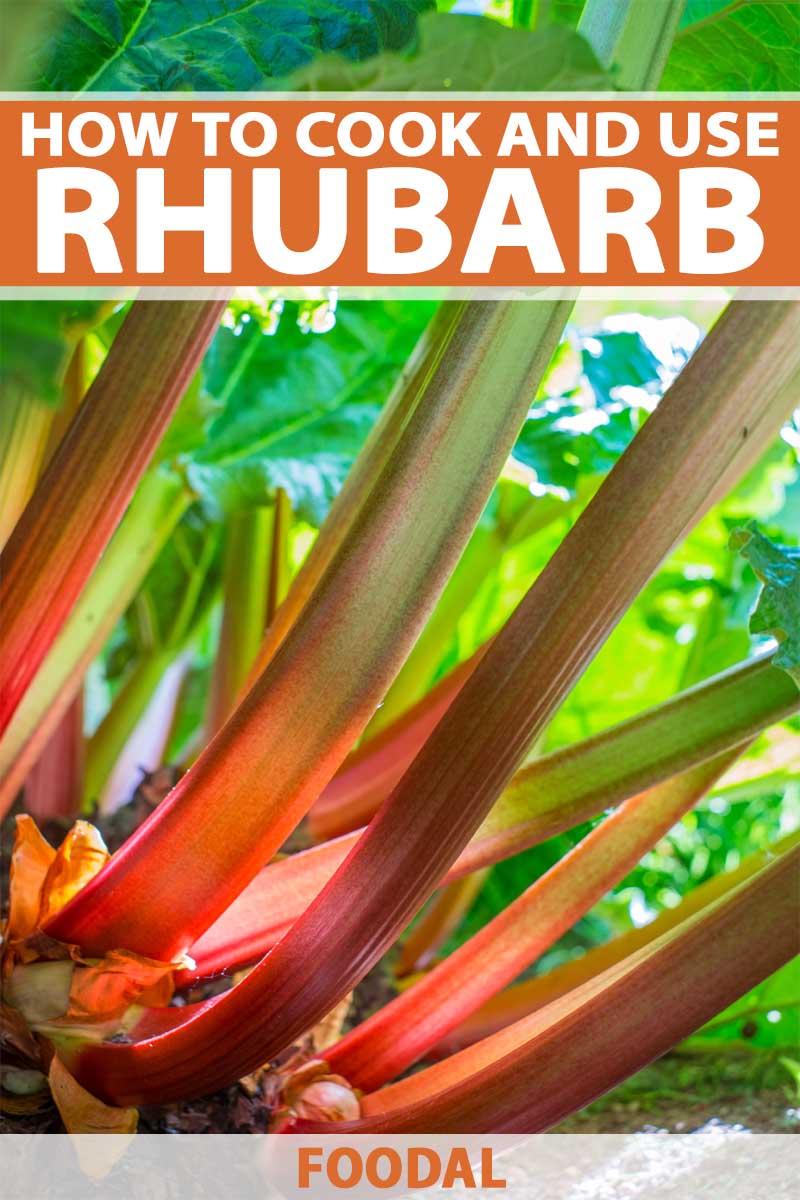
By May or June, the plant’s edible stalks lengthen and blush with pink in the garden – while bunches of it flood seasonal grocery store shelves, farmers market tables, restaurant menus, and kitchens everywhere.
So many people get excited for rhubarb. And when they do, you’ll know that spring is in full swing!
Have you ever used it before? Do you know what to look for when selecting it?
Have you only ever tried the classic strawberry rhubarb pie, and want to venture into some fresher territory to liven up your spring table?
Foodal has some new ideas. Read on to learn a little more about rhubarb basics, and how you can prepare this celery-like produce – along with the juicy stalk’s nutritious and health-supporting benefits.
What You’ll Learn
What is Rhubarb
Rhubarb is often called a fruit but is actually a vegetable. Scientifically (in full unadulterated technobable), it’s a plant in the genus Rheum under the family Polygonaceae. It is a cultivated herbaceous perennial which grows from short and thick rhizomes.
Rhubarb first came into use as medicine in which the roots were usually used. Later, the edible stalks were prepared as food and that’s how most folks know them today.
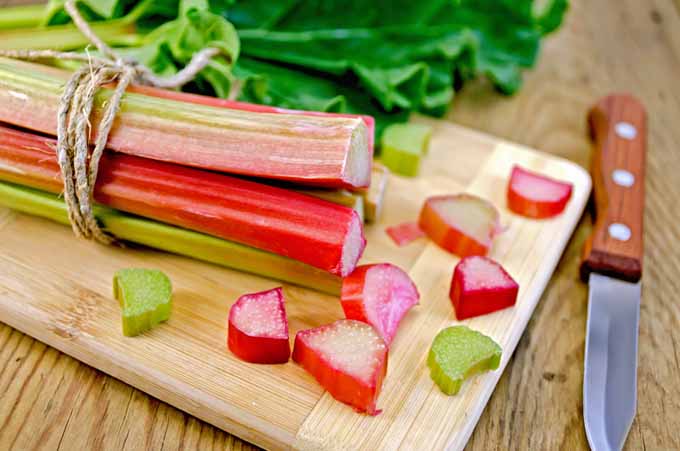
Rhubarb actually a vegetable but is often (and sometimes legally) considered to be a fruit. A New York court, in 1947, declared that it be tanamount to a fruit as it’s often prepared as one (this court decision was based on tariffs as imported fruits had higher taxes at the time).
It’s often found at farmers’ markets and in the produce departments of grocery stores where it’s sold by the stalk similar to celery. It’s a seasonal vegetable (or fruit?) which lasts from April to June.
The stalks are usually a vivid pink purple color but some varieties are a pale pink and sometimes green. As we will discuss further below, avoid the leaves as they are inedible and full of toxins.
Taking “Stalk”
What’s that funky, big-leaved patch of plants popping up in your yard?
It might not be weeds after all – but a well-kept rhubarb patch planted years ago!
It’s a traditional pastime to get this veggie straight from your garden or personal patch, and something you might be aware of already in your own yard.
But do you know how to harvest it? Or do you have what you suspect to be a rhubarb patch, but you don’t know where to start?
Harvesting is simple: with a knife, simply remove the stalk as low down on its base as you can, right above the earth.
Be sure to remove the leaf that’s attached by cutting it completely away before preparing or eating. Some farmers market vendors like to leave the leaf attached for some aesthetic beauty, but these really shouldn’t be brought into your kitchen.
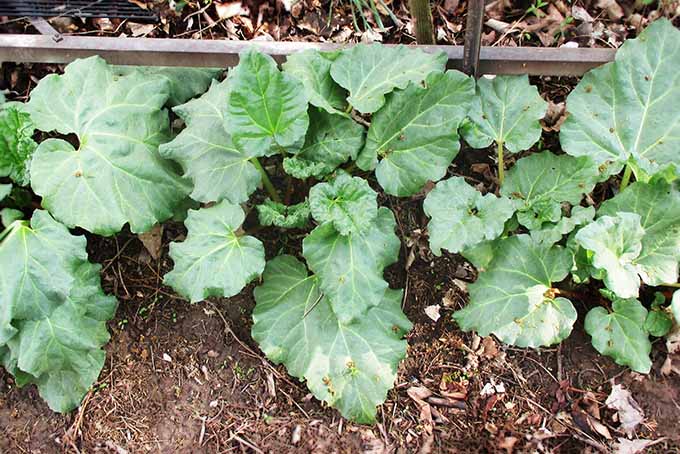
Why is this important? What some may not realize is that rhubarb is actually a potentially toxic plant, containing high amounts of oxalic acid in the leaves and roots. When eaten, these parts could negatively affect kidney health, and make you very sick.
But don’t let that scare you! It’s always safe to eat the stalks, which have much less oxalic acid than other parts.
Don’t have a patch near you? You could always consider growing your own. You can find a detailed growing guide on our sister site, Gardener’s Path.
Otherwise, all sorts of places – including grocery stores and farmers markets – will have plenty from garden or field. Head there when rhubarb season arrives, and hand-pick your very own to bring home.
Buy it Fresh
The only downfall of not growing your own rhubarb? You’ll have to check for freshness, wherever you buy it.
It’s quite simple to test the stalks to determine how recently picked and ready-to-eat they are. At a glance, they should look quite a bit like celery, but they will be very pink or green, sometimes both – the pinker, the better!
Here’s a few more additional tips:
- Test stalks lightly with your fingers – would they snap in half if you tried? They won’t feel as crisp as celery (a bit rubberier), but if they are so rubbery you don’t think you could snap them, then these stalks are past their prime.
- Gently squeeze the stalks. You should feel that pressing the skin hard would crack it, rather than leaving an impression. If they’re on the soft side and a bit too pliable, you probably want to pass these up.
- Give the coloration of the stalk skin a good look, too – especially at the ends of stalks where they have been cut. Do you see brown, black, or yellowish spots? Are the cut ends starting to look yellow and dried out? This shows that age has begun to settle in. You could cut those portions away if the middle of the stalk is still fresh – but then again, you may want to choose fresher stalks that have not oxidized so much with age.
- Examine the size, width, and color of each stalk. Is it pale rather than vividly hued? More yellow and green, with less pink? Go for stalks that are larger and pinker. These will have a longer shelf life – and less red ones could have been picked too early, before becoming fully ripe.
Storage
The season for rhubarb comes and goes, but your hankering for a little more of its tang in your life might stick around – sometimes long after it’s gone!
For that reason, you’ll want to save some of it for storage, even after it’s vanished from produce aisles, market tables, and your garden.
The wonderful news: holding onto it is easy.
If you think you’ll be using it relatively soon, simply sticking it in the fridge for a few days wrapped up in a plastic bag suits just fine. A crisper drawer is ideal.
Want to make it really last? Blanche and freeze it!
This won’t keep it crisp and perfectly-textured forever, but will certainly preserve its flavor, and even vitamins, minerals, and associated health benefits.
Here’s the basics:
- Clean the stalks thoroughly under cool, running water, being sure to remove any dirt from the surface. Cut away any dried-out ends.
- Chop up your rhubarb into somewhat coin-shaped bits, or quarter it, to make blanching more successful – smaller bits blanch faster and more thoroughly, making them more cooking-ready as well.
- Place two pots of water on your stove: bring one to a boil, leave the other at a very cold temperature – if your kitchen sink doesn’t run very cold, add some ice.
- Place the chopped stalks in the boiling water, until the color becomes more vivid. At the advice of this article from SF Gate Healthy Eating, the best blanching time is about 30 seconds.
- With a strainer or spoon, immediately remove from the boiling water, and place in the cold water to cool. 30 seconds is the optimum time for cooling as well.
- Thoroughly drain the chopped vegetables and pat the stalks dry. Then seal them in an airtight plastic bag, and place in the freezer for long-term storage.
After blanching and freezing your rhubarb, all you have to do before preparing it in a recipe is defrost it a little. Give it a chance to at least start to thaw out in the fridge or on a kitchen counter, and it’s ready to use – no matter what you want to use it for.
Frozen, this will last for about a year. When spring comes back around again you’ll want to toss out the old to make way for the new – newly picked stalks, that is – but we’re sure you’ll love the taste of rhubarb so much that your frozen stash will be long gone by then!
Of course, recipes that call for fresh might not fare so well using the blanched, frozen variety. All the same, let’s take a look at the wide variety of things you can do with it in the kitchen – whether fresh or frozen – and some other ways to tastily preserve it for the long haul!
How to Use Rhubarb
As the excitement of rhubarb season draws near, I’m sure you’re looking forward to making your favorite recipes.
Maybe it’s that traditional strawberry rhubarb pie – a classic we’ll discuss – but let’s take a look at some other options for this stalky, pink vegetable as well.
Pie Fillings and Baked Goods
It’s a popular choice in this category – the reddish stalks go wonderfully in pie crusts, as well as sweet breads and pastries of all kinds, its tartness being a strong compliment to sweet flavors.
A favorite flavor pairing, as you may very well know: strawberry! Strawberry rhubarb pie is a classic, along with the more straightforward rhubarb pie.
To make your own pie filling at home, the stalks are typically stewed with a bit of sugar and juice, and then egg and a thickener (like tapioca, arrowroot, or cornstarch) is added to form a soft filling.
I would suggest Foodal’s excellent recipe to get started. This could also provide the base recipe for other popular fillings – such as for danishes, pastries, and much more, combined with or without strawberries.
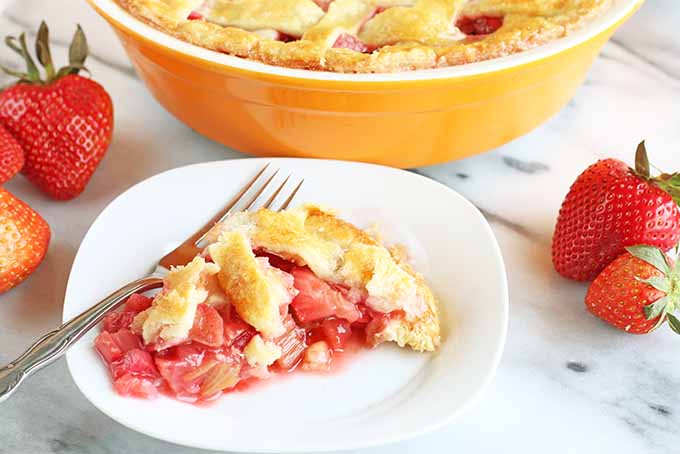
Classic Strawberry Rhubarb Pie
What else can you throw in the oven that has a rhubarb twist? Cakes, Dutch oven bakes, crumbles, crisps, cobblers, and turnovers are great examples.
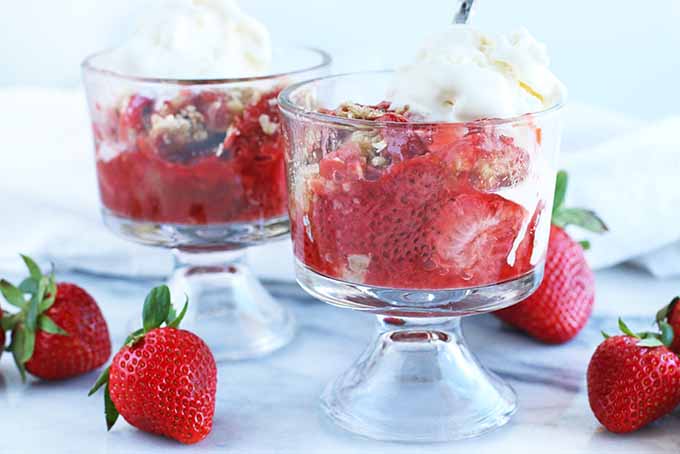
You can also try Foodal’s very unique, delicious rhubarb and nut loaf recipe here – which features sweetness with the nutty taste of almonds, and that sour touch of spring’s favorite pink produce.
Canning and preserving it as a jam, jelly, or preserve can make the creation of fillings (or even compotes, syrups, and marmalade) much easier in the future, too! Consider using these as toppings for oatmeal, granola, cereal, yogurt, muesli – whatever your favorite quick and easy grain-filled or calcium-rich breakfast may be.
You can learn how to master the technique and preserve yours for even longer with the help of this post on canning, jamming, and preserving.
Creams and Sweets
Elaborating further on that sweet note, rhubarb is a confectionery sensation. Not only does it have an affinity with sweet desserts, there seems to be a magical connection between these pink stalks and dairy too – especially creams and ice cream.
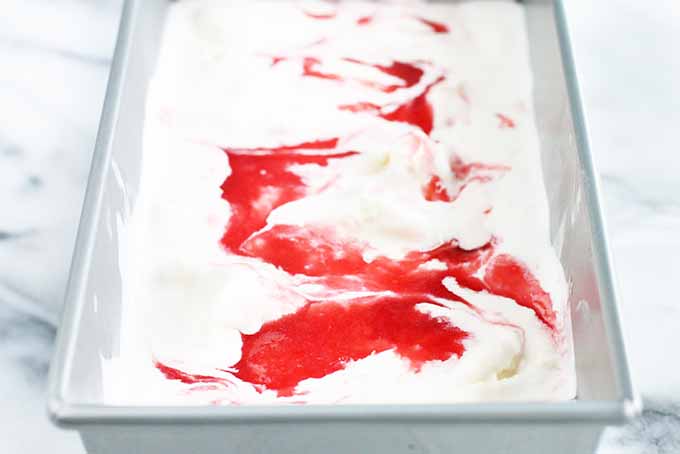
The stalky, juicy produce makes for a great ice cream flavor, but it also pairs excellently with other sweet creams and fluffy whipped egg whites, too – like a dessert cream sauce or tasty meringue, as in this wonderful recipe.
Got an ice cream maker (or want to get one)? Do you already have a favorite gelato, sherbet, semifreddo, or sorbet recipe?
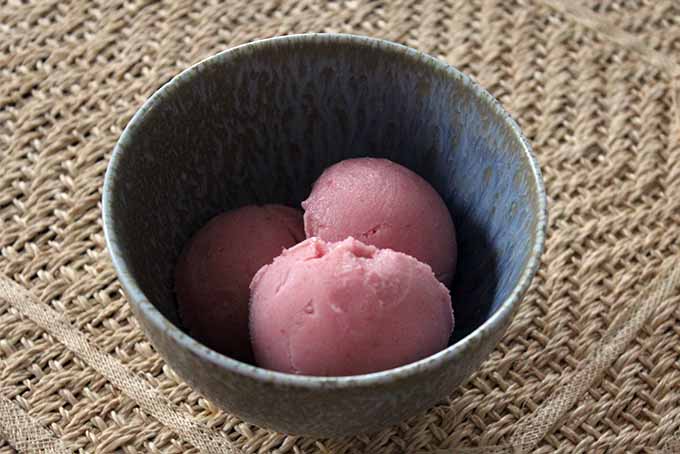
Tart and Creamy Rhubarb Buttermilk Sherbet
Consider rhubarb for your next seasonal flavor. It will pair wonderfully with a few other flavors in a homemade ice cream – not just strawberry, but also raspberry, ginger, and vanilla, just to name a few.
Sauces and Glazes
It may surprise some how well rhubarb fits into sauces when a tart, tangy note is needed.
Some more savory glazes for meat, poultry, and other foods call for the plant – as well as complex sauces for springtime, even barbecue (that’s right: “rhubarbecue”)!
Next time you’re whipping up a glaze, sauce, or even a marinade, consider fitting this springtime favorite in there somewhere. It can make the flavors of pork, duck, and fish – especially trout – really pop.
Think too about adding it to blends that feature vinegar, white wine, honey, fennel seed, garlic, cloves, and of course, sweeter things like raspberries, strawberries, and citrus.
Crush and mince the stalks up into tiny pieces, and toss them into a sauce or dressing – or simmer larger chunks in your sauces for straining out later (or not – it’s up to you).
Juices and Drinks
Think of what a pure rhubarb juice would taste like – probably pretty intense! It wouldn’t be too far from a mouthful of Sour Patch Kids.
Still, its addition to juices, libations, and cocktails is becoming a very popular thing nowadays – when it’s added in small amounts or diluted, of course, such as from juiced stalks, simple syrups, or vinegars. You can use these to prolong the shelf life of the fruit, to create flavoring add-ins with a smack of sourness. Even a small amount can pack a punch!
Think of a refreshing strawberry lemonade for example, with a dash of juiced rhubarb. It would be the perfect refreshment for late spring, as temperatures truly start warming for summer.
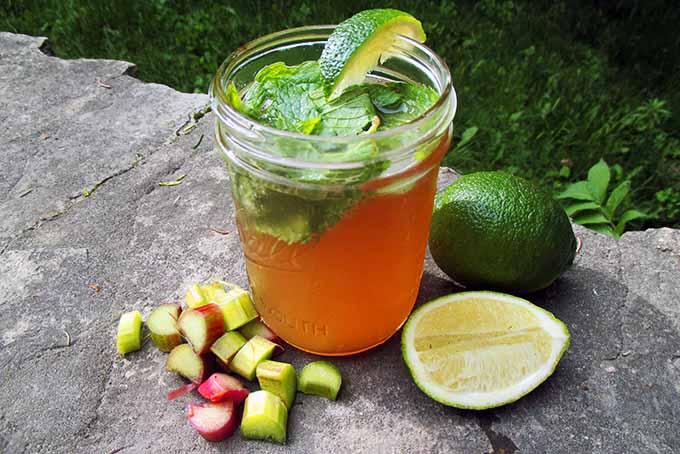
A Super Tasty Rhubarb Mojito Recipe
How to capture the stalk’s essence? Juicing is one method, and it’s easy.
You can clean and chop up the stalks, place them in a blender or food processor (with a bit of water or juice that would go well with it, flavor-wise), and chop them up. Afterwards, strain out the remaining fibrous chunks (if you desire) and store in the fridge in a sealed glass jar or bottle. Straining out the bits can help to extend the shelf life a little more as well.
Or, you could run your cleaned and chopped pieces through your juicer, if you have one. A juice will last only a couple days before it begins oxidizing – but if you add quite a bit of vinegar, lemon, or lime juice, this can help to preserve it for a bit longer, perhaps for a week.
If you really want that flavor to go the extra mile, you can make it into a vinegar soak (also called an acetum). Here’s how:
- Simply chop up the stalks as small as you possibly can, and pack them into a jar.
- Pour vinegar over them until the jar is full. I like to use apple cider vinegar, and I would avoid white distilled or balsamic.
- Place in the fridge, and wait about a week. Give it a taste, to see how the extraction is coming along.
The vinegar will extract some of the rhubarb flavor, even after you strain out the stalk pieces – typically after a week or two.
If you’re looking to sweeten up your stalks, a syrup could work amazingly – and you’ll find an excellent fruit syrup recipe right here on Foodal that you can easily incorporate rhubarb into. This can be stored in the fridge for several weeks.
Add a dash of any of these to juices, sodas, sparkling water, tonic, or even mocktails and cocktails. This will make them all the more thirst-quenching – especially drinks that already include flavors of ginger, citrus, berries, apples, mint, or even wine.
With tangy fermented drinks like kombucha, shrubs, and vinegar drinks, rhubarb fits in seamlessly as well!
So this spring, consider juicing your stalks – it does lengthen the shelf life a bit (especially by preserving it with a touch of added vinegar), and you can add a few sloshes of it to drinks, sauces, and other recipes… whatever you like!
Add a Little Heat
Rhubarb is not just reserved for refreshing, sweet treats – other cooking techniques provide a more savory way to enjoy its delicious stalks, too. Many people have been known to roast them to great success, very much like a vegetable.
You can also cut them up into pieces, thick (for a gummier product) or thin (for a crispy version), and dehydrate them.
Don’t have a dehydrator? Check out our guide to the best dehydrators on the market today.
You could cut them up thin and roast them low and slow in the oven, too – they’ll crisp right up. This will help to preserve them for longer periods like you would any other dried fruit, especially with the addition of oxygen absorbers.
When doing any cooking with rhubarb, keep its high acidity in mind!
Whether roasting, stewing, or whatever your preferred method, avoid cookware made of aluminum, cast iron, or copper. The acids will react negatively with the metal, both tarnishing your food and your cookware.
Reactive metals can leach into your food as well. For that reason, stick to coated pans, glass, or even porcelain cookware instead.
Flavor Pairings
What does rhubarb taste great with? We covered a few potential flavors above – but let the more complete list below inspire you to include it in some other meal preparations this spring.
Some of these combos are suggested in Karen Page and Andrew Dornenburg’s culinary classic, The Flavor Bible, available on Amazon.
Protein
- Chicken
- Duck and game birds
- Eggs
- Liver
- Pork
- Trout
Fruits
- Apples
- Citrus (grapefruit, lemons, limes, and oranges, especially blood oranges)
- Plums
- Raspberries
- Strawberries
Dairy
- Butter
- Buttermilk
- Cheese (blue, Stilton, mascarpone)
- Creme fraiche
- Sour cream
- Yogurt
Veggies, Nuts, and Grains
Herbs, Spices, and Condiments
Health Benefits
Not only does rhubarb make for an exciting spring ingredient, it also touts some awesome health benefits – along with a few effects to be more cautious of.
Since the plant originates from China, the tasty stalks have been used in Traditional Chinese Medicine (TCM), along with the more dangerous root. These were used to regulate digestive disorders, and both constipation and diarrhea.
Such use still holds today. Due to the plant’s anthraquinone glycoside content (especially in the root), it was most successful as a laxative – and eating enough of the stalks, whether only slightly cooked or raw, can lead to a laxative effect (though it also helps with diarrhea).
Take care not to eat excessive amounts of raw or lightly cooked stalks, as the anthraquinones and oxalic acid quantities can be harmful to health – possibly causing digestive or kidney disruption.
Of course, take care NEVER to eat the leaves since they are toxic, and NEVER use the root without the expertise or advice of a trusted health care practitioner.
Of course, eating truly excessive amounts this can be quite difficult to achieve, due to the intense taste! You’re more likely to get a stomachache, or become completely sick of eating it first.
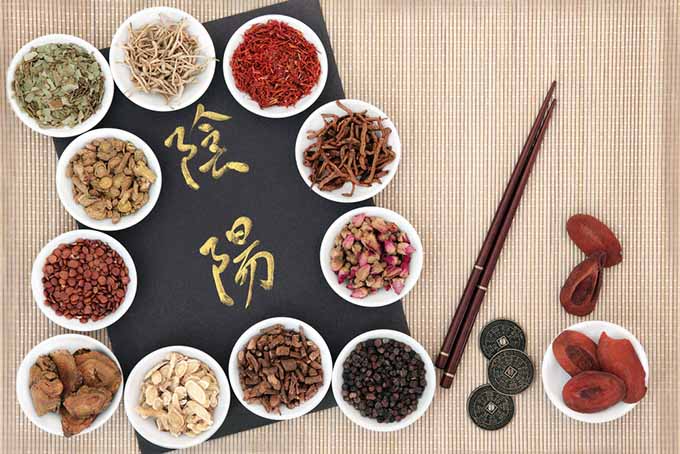
Some studies are also hopeful that compounds in rhubarb could kill cancer cells, while it also contains a high amount of antioxidant activity – also good against cancer! However, these findings need a bit more exploration before it’s officially considered curative.
As a nutritious fruit – or vegetable, whichever you prefer – rhubarb is a significant source of vitamins C and K, calcium, iron, fiber, potassium, and manganese, according to NutritionData.com. Cooking or stewing the stalks releases yet more of some of these nutrients, particularly calcium and K.
Recipe Ideas
Big-Crumb Rhubarb Coffee Cake
If you are a lover of coffee cake than this recipe will knock your socks off. Big buttery crumbs on top are the crème de le résistance of this tasty dessert but they don’t cover the tasty layers of moist cake and the tart rhubarb filling.
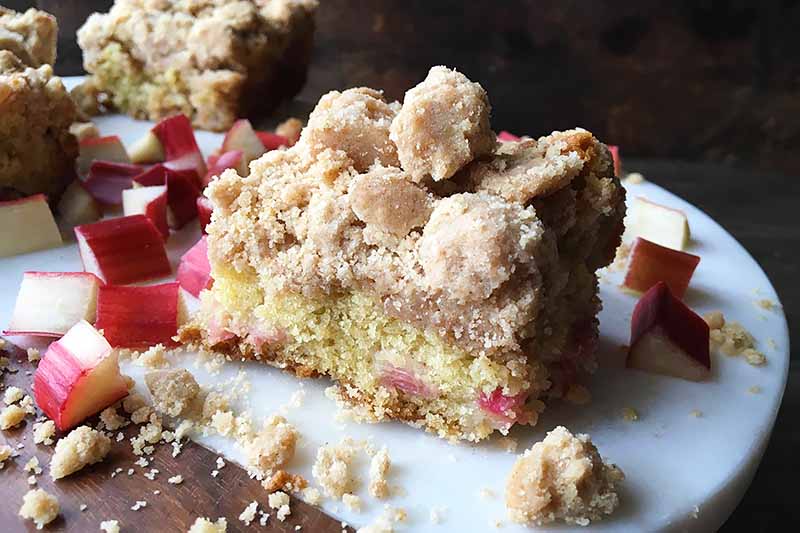
It’s great for brunches, lunches, or as an after dinner treat.
Get the recipe here on Foodal now.
Tangy Lemon Rhubarb Spelt Cake
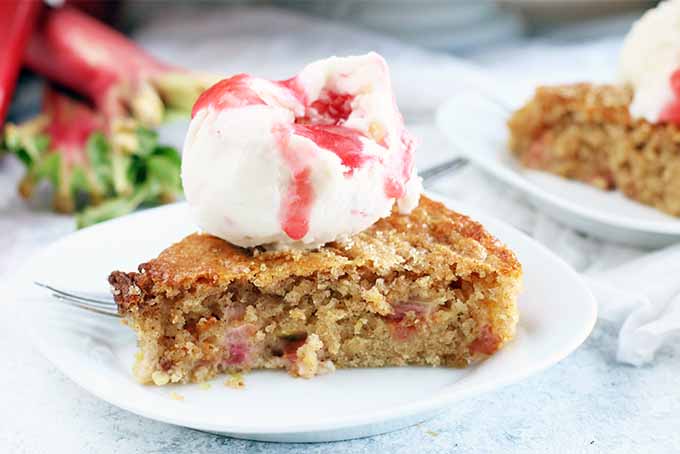
Looking for a tasty treat for a spring or summer picnic? Then this spelt cake recipe is for you. With no frosting, it’s simple to prepare and no worries on destroying a fancy decorative icing job in transport.
But the simplicity doesn’t take away from the flavors of fresh lemon and tangy rhubarb or the dense and moist texture of the whole-grain spelt flour. It’s also a great choice to serve with ice cream at barbecues and cookouts.
Homemade Rhubarb Fruit Leather
Boil it, smash it, add a bit of sweetener of your choice, and dehydrate it and you can make your own tasty fruit leathers with the stalks of our favorite veggie (um fruit?).
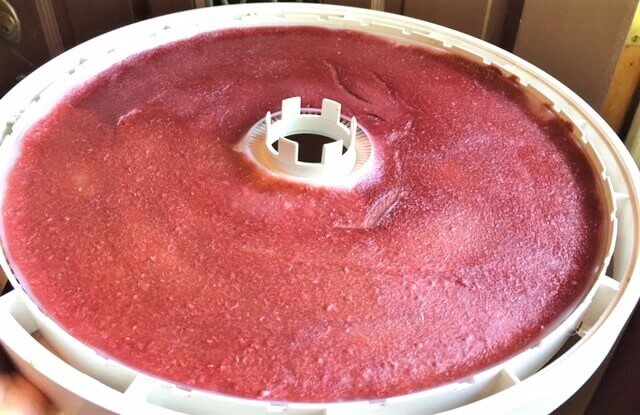
You can find all the details for the leathers over at our friends Healthy Green Savvy.
Rhubarb Yeast Loaf
Sweet, surgery dough joins crunchy almonds along with the tartness of rhubarb to create something extra special.
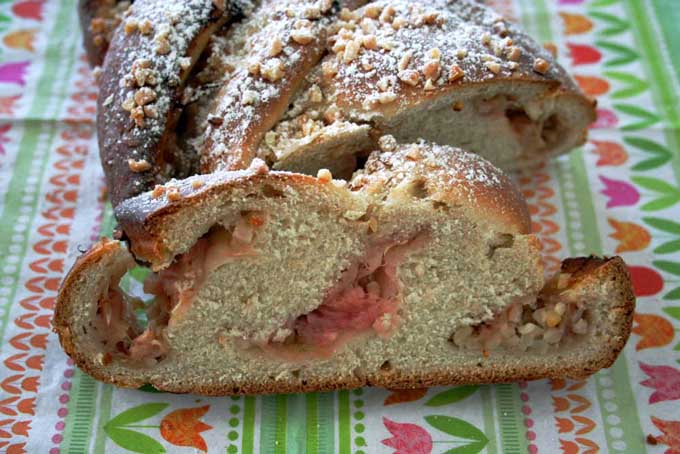
With the unmistakable taste of yeast, this bread will soon become a spring-time tradition in your family.
Get the recipe here on Foodal.
A Herald of Spring
Rhubarb is truly a food to get stoked about in the spring. We love it in pies, and pairing it with strawberries – but really, there is so much more you can do with it!
You don’t have to just enjoy it in the springtime, either. Through various methods of preservation – blanching, preserving in jams, or juicing – you can make your pink, delicious stalks go the extra mile.
The most important tip of all in getting the very best out of this food? Make sure you pick out the freshest and most pristine stalks at the grocery store or farmers market.
According to nutritional research and traditional knowledge, it could be a fairly healthy addition to your diet (if you don’t drown it in too much sugar)!
What are your experiences with this tangy vegetable? Any unique recipe ideas, experiences, or remixes and fresh versions of old favorites that you’d like to share? We’d love to hear from you!
The staff at Foodal are not medical professionals and this article should not be construed as medical advice. Foodal and Ask the Experts, LLC assume no liability for the use or misuse of the material presented above. Always consult with a medical professional before changing your diet, or using supplements or manufactured or natural medications.
Photos by Meghan Yager, Meghan Yager, Kendall Vanderslice, Adrian White, Nikki Cervone, and Nina-Kristin Isensee© Ask the Experts, LLC. ALL RIGHTS RESERVED. See our TOS for more details. Fruit leather photo courtesy of Healthy Green Savvy. Uncredited photos: Shutterstock. Originally published on April 22, 2016. Last updated: January 6, 2023 at 9:26 am.
About Adrian White
Adrian White is a certified herbalist, organic farmer, and health/food writer and expert. She aims to bridge the world of natural, holistic health and nutrition to the realm of organic foods, herbalism, gardening, and sustainability - or "Food as Medicine" - throughout her writing.

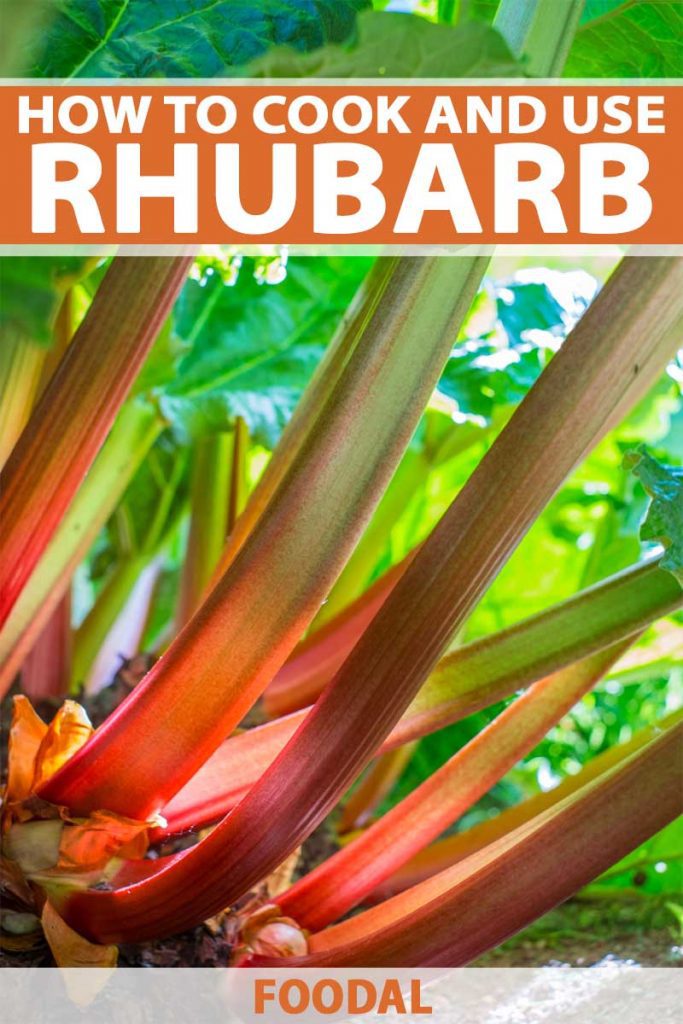
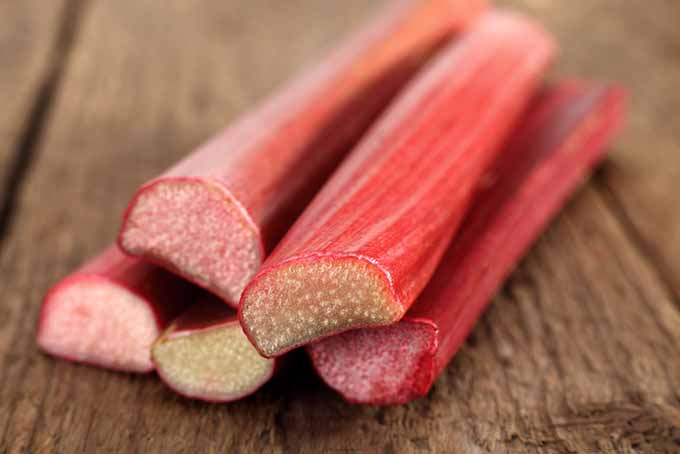

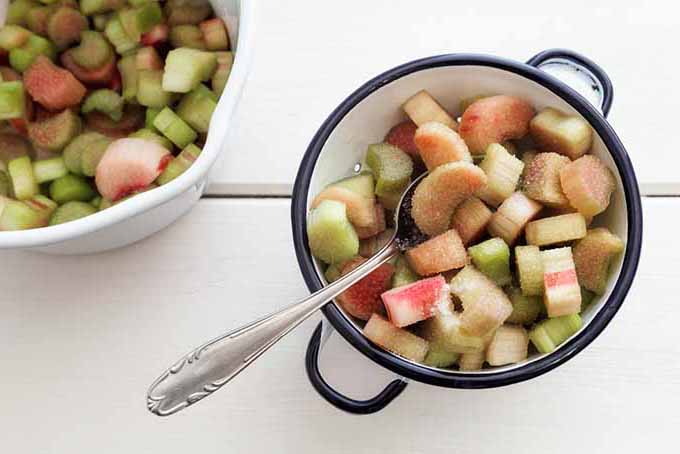
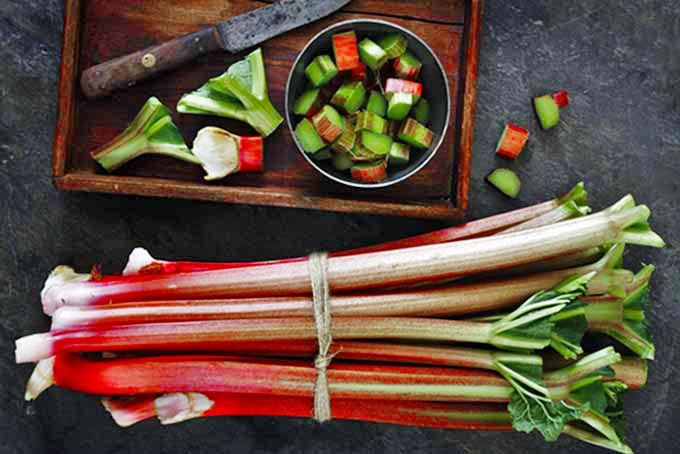
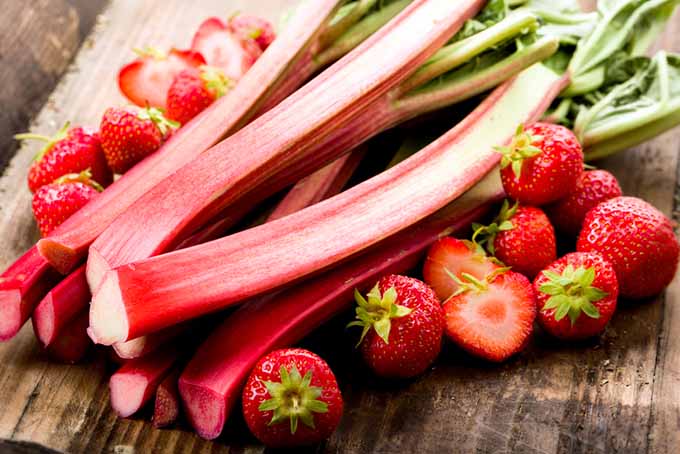



I have been hesitant to attempt to make strawberry rhubarb pie for years, mostly because I didn’t want to end up with a sub-par pie (is there anything worse?). This post has sparked my inspiration to face my fear and head to the nearest farmers market! Thank you so much for the very detailed description on how to choose fresh, ripe stalks, as well as the “outside the box” recipe suggestions this wonderful plant can create! Especially excited to to incorporate it into our summer rib cookouts!
Thanks for your words and reading, Xina! These tangy stalks really could be called “weird” – but when it comes to using them, not daunting at all and it’s hard to mess them up, actually. And yes – please try a “rhubarbecue!” It’s delicious and a fun spring invention my husband came up with one day (though if you look online – not so original after all!)
I’ve only ever got it straight from the garden, and perhaps because of that I didn’t know the freshness tests, just to cut it right before use and check for slugs or caterpillars. I never knew the leaves were poisonous, just that you cut them off before eating, so thanks for the eye-opening read.
We usually make a Rhubarb Crumble – like apple crumble except using rhubarb – but I’d never considered all the other things you can do with it. My plant might lose a few more stalks this year. Rhubarb Crumble can be very nice, although trying to persuade a younger visitor to eat it was quite difficult. They were rather unsure about the colour!
Katie – thanks for reading! The freshness test is really only something to worry about if you purchase it. Of course, if you pick stalks right out of your garden, they’ll be fresh as fresh can be.
Some folks will say “only pick them when they’re really pink” for the best flavor, but I myself am not always that patient! I will still enjoy stalks that are yellow-green, only with a touch of pink – and sometimes the amount of pinkness you find really depends on the variety you grow. Also, the pinker color might be a bit more convincing to those younger visitors 😉
Some rhubarb varieties don’t ever get pink b/c they are a green variety. So the pink rule doesn’t really apply. I have a plant that is about 1/2 and 1/2.
I have never tried this vegetable but your post intrigued me. I had no idea you could make so many delicious things with it and I’ll definitely buy it the next time I’ll go to the farmer’s market. I have a big garden so I’m also thinking about growing my own. Thank you for the great tips about harvesting, cleaning and stashing it, now I know what to look for when I’ll buy it and I’ll make sure to follow your advice in regard to its freshness.
Snarya – thanks for checking out our article. It’s definitely worth giving these stalks a try – especially growing them. I harvested some rhubarb from my own patch just yesterday morning, and it saves me an entire trip or having to worry about freshness in the least!
To be quite honest, I have never really heard about Rhubarb before reading this article and it definitely interests me. Whenever I try out new foods, I always look for health benefits they might bring me and it is packed with vitamins, minerals, other nutrients and that is totally a plus! Searching through images of the pie and cheesecake, I can say that this is definitely something I’m willing to try and make. Will have to find this (fresh) gem first!
Canary, I’m so glad this article got you in touch with this vegetable! I was closed off to it for most of my life myself – but not because I had never heard of it, but because I always categorized it as what I liked to call “grandma food” (along with other veggies like rutabagas and parsnips) when I was a kid. Little did I know that when you grow out of candy and hamburgers, grandma food is the best. And rhubarb is no exception!! You’re bound to find it at most grocery stores and farmer’s markets this time of year.
Rhubarb is the best! I remember picking it from the side of the house with my Nan as a child. We would promptly make jam and pie from our harvest. We wouldn’t use strawberry with it, as we lived in the north where strawberries never came until near the end of summer. Another bonus is that it takes little to no care to grow. We would just pick what was there every summer with no prep of any kind.
Thanks, NeverEnoughCheese! I actually prefer it without the strawberries myself, though I must admit that strawberries are my favorite fruit.
And yes, it is ridiculously easy to grow and manage. Worth planting in your yard, and a great introduction to gardening. So easy to pick, too!
I remember in my childhood reading about rhubarb pies in books and was always curious about it. My family never grew it or used it in any dish.
When I spoke to my mother about this, she said that her grandmother used to have a patch in her garden, so maybe its up to me now to bring this veggie back to the family kitchen.
Thanks for reading, Vegan93. I didn’t grow up with it at all, either, until a friend introduced me. She snapped off a stalk, pulled off the leaf, and told me to suck on it and then stick it into a jar of sugar so it was completely encrusted – and then chew away. Let’s just say that converted me pretty quickly!
Planting it in your garden is incredibly easy, and virtually maintenance free. There are tons of guides online that could help you get one in your yard!
This year I put a bucket upside down over my rhubarb crown and this weekend I should have the very first stalks ready to cut. I’m really looking forward to it. To me it’s the first real intimation of summer. And rhubarb crumble is my all-time favourite!
Thanks for reading, SueTobias! I have never used the bucket method, and would be curious to hear what it is good for – is it for protecting your crown over winter? Thicker foliage and stalks? Something else? I have three or four plants in my front yard that could use a boost, and anything helps!
A…. we use to live in Kingaroy Queensland Australia and my mum grew rhubarb beside the outside loo. She put an empty paint drum, (bottom cut out) over the plant to lengthen the stalks and I think also for some protection……..we grew up on rhubarb pie or just plain rhubarb and icecream……….. I have just started some small plants and they are doing real good
Thanks for the info. Cheers Brian
Well, here we are at the end of the season and the bucket worked well to give me the first stalks – I think it’s called “forcing”, which is pretty much what it says on the tin. I took the bucket off after the first couple of pies and my plant has produced steadily over the summer and up to last week, roughly enough for a small pie a fortnight. Do you like the idea of production measured in pies? : -) It’s stopped producing new stalks now. I think the most important thing is to keep the plants well fed – they like really rich soil. I shall earth the crown up before the weather gets too cold. Hope yours grow well and you’ll be back in business next spring!
For the past few years, I’ve been seeing articles that say you can boil Rhubarb stalks into a gooey paste to make a solution for cleaning burnt & stained Aluminium pans, well take my advice and stop!
Doing this is just a waste of a delicious (and nowadays expensive) vegetable. Boil your rhubarb as you would to make your Crumble desert or other culinary delights which takes only a few minutes.
Once cooked to your preference, remove the Rhub or strain but do not throw away the water. Instead, add as many of the Rhubarb leaves as you can into the hot water. Ripping the leaves into smaller pieces helps release the active toxins more quickly into the water. let it simmer until it reduces and then remove from the heat and let it steep in the pan until cold. The more you mash in the leaves the better but you can remove them if you want. You then use the paste or liquid to paint or soak your offending pans for an hour or so before giving them a quick scrub and rinse leaving them nice & clean. the liquid can be stored in jars as well for quite a while. I remember my Grandma doing this quite often when I was a kid in the 60s. Granddad used to grow yards & yards of the stuff behind the old corrugated loose boxes in the lower field.
My Grandmother in Yakima, Washington, grew rhubarb in her back yard and made pies that were SO delicious ! A pie rarely lasted a day ! I haven’t had any rhubarb pie since my Grandma passed away in 1963, but I will always remember her and her heavenly rhubarb pie!
We have a steam extraction juicer and rhubarb is a favourite to juice as it has a very “clean” taste to it and as the variety I grow is Sydney Crimson the colour of the juice is great. I used to put a small amount of sugar with it but forgot in one batch and since then have realised just how nice it is unsweetened. About a fifth of a glass of juice topped up with rainwater, magic, first thing in the morning.
My mother-in-law made a sauce of rhubarb. Cut it up, added sugar and 1/2 cup water to pot. Boiled it til soft and mashed it up. Took off burner and added small pack of strawberry or cherry Jell-O. Let cool. Rhubarb Jell-O! Delicious!
Wow, sounds fantastic! Thanks for sharing, Suzanne.